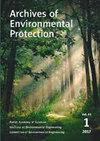通过岩石学分析、筛选评估和光学成像来估计海滩砂中的固体污染物水平
IF 1.3
4区 环境科学与生态学
Q4 ENVIRONMENTAL SCIENCES
引用次数: 0
摘要
本文章由计算机程序翻译,如有差异,请以英文原文为准。
Estimating solid contaminant levels in beach sands through petrographic analysis, screening evaluation, and optical imaging
: Determining the level of solid pollution in beach sands located near artificial inland water bodies in order to maintain high safety standards is a difficult and expensive task. The tests aimed at determining beach pollution caused by solid wastes through analysis of toxic and chemical concentrations, are time-consuming and usually require several days before the results are available. In addition, the maintenance of the beach area involving beach raking or grooming, and the seasonal replenishment of sand makes it difficult to realistically determine the chemical or bacterial contamination of the tested material. Solid pollutants, such as glass, caps, cans, thick foil, metal, and plastic fragments, pose a greater health risk to beachgoers. The above-mentioned pollutants, especially small ones, are hardly visible on the surface or they are buried at shallow depths. Beach garbage poses a serious threat that can lead to infections from cuts and scratches. These injuries can become infected, further jeopardizing the health and lives of beachgoers due to risks like tetanus, staphylococcus, etc. The authors presented a new petrographic method aimed at assessing the quality of sand by examining the content of solid pollutants. The obtained results allowed us to conclude that the mentioned procedure can be used for a quick quantitative estimation of the content of potentially dangerous and undesirable pollutants in beach sands. Consequently
求助全文
通过发布文献求助,成功后即可免费获取论文全文。
去求助
来源期刊

Archives of Environmental Protection
ENVIRONMENTAL SCIENCES-
CiteScore
2.70
自引率
26.70%
发文量
0
期刊介绍:
Archives of Environmental Protection is the oldest Polish scientific journal of international scope that publishes articles on engineering and environmental protection. The quarterly has been published by the Institute of Environmental Engineering, Polish Academy of Sciences since 1975. The journal has served as a forum for the exchange of views and ideas among scientists. It has become part of scientific life in Poland and abroad. The quarterly publishes the results of research and scientific inquiries by best specialists hereby becoming an important pillar of science. The journal facilitates better understanding of environmental risks to humans and ecosystems and it also shows the methods for their analysis as well as trends in the search of effective solutions to minimize these risks.
 求助内容:
求助内容: 应助结果提醒方式:
应助结果提醒方式:


